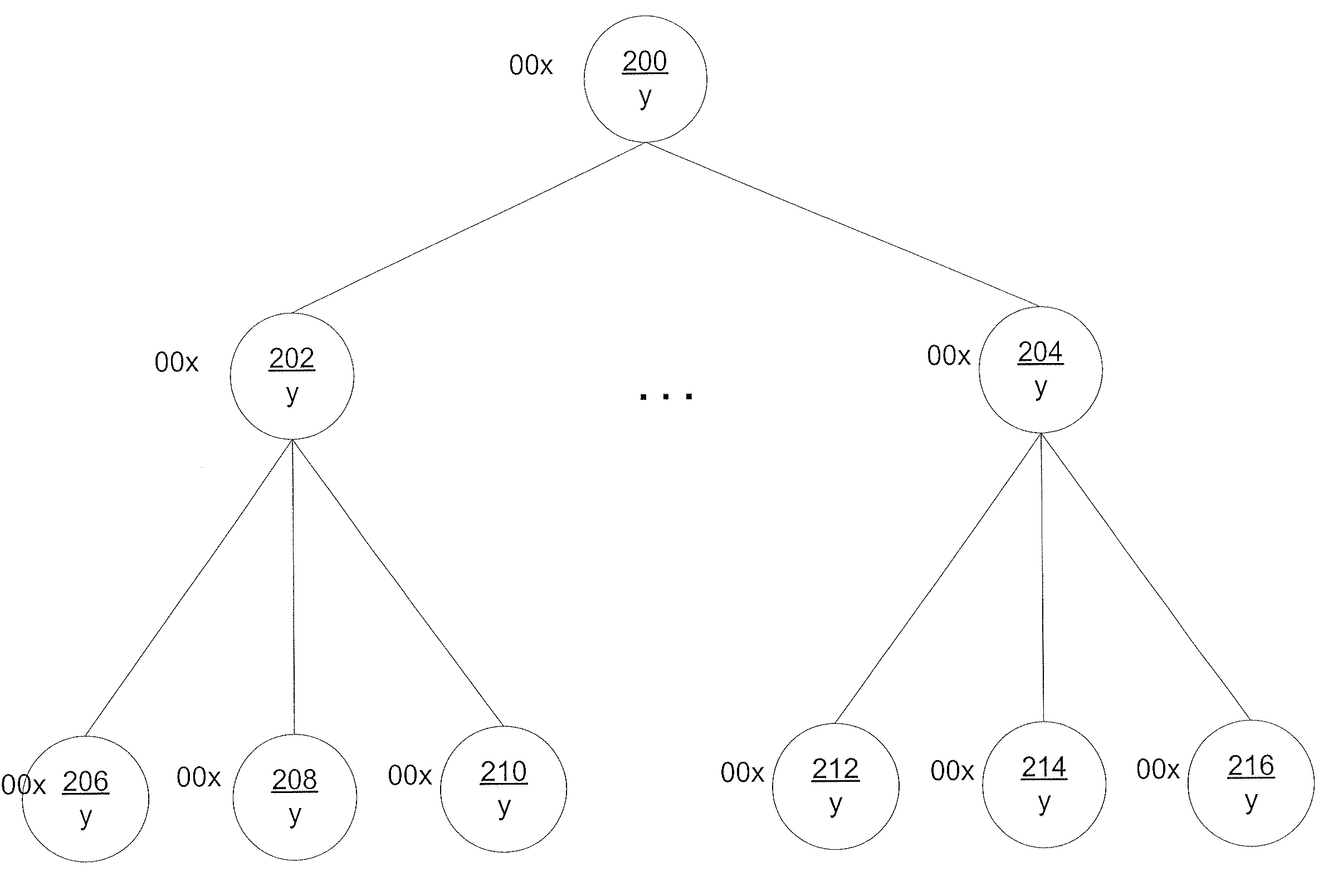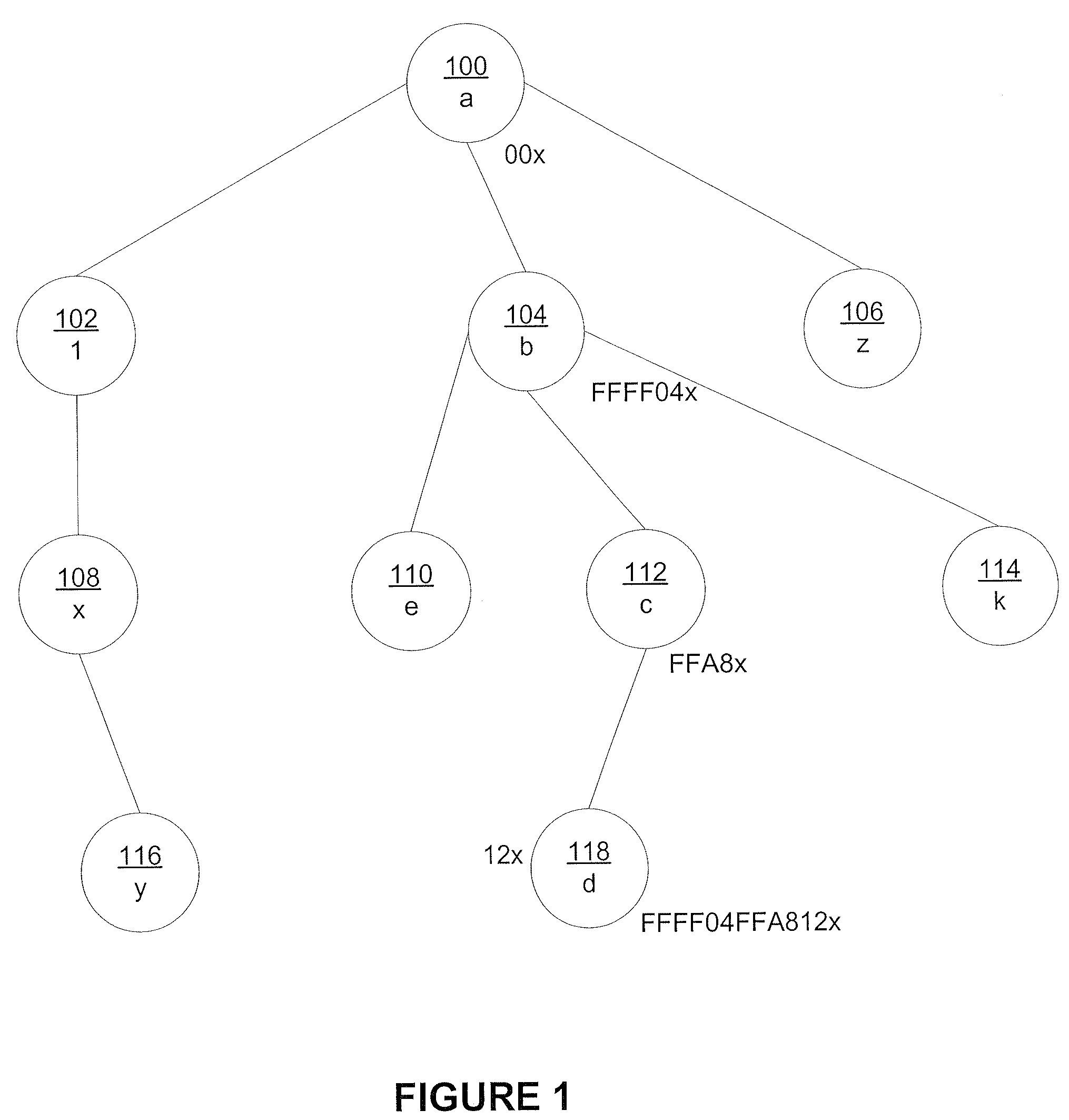Self-Adaptive Prefix Encoding for Stable Node Identifiers
a prefix and stable node technology, applied in the field of xml node identifiers, can solve the problems of reducing the possibility of skewed encoding and long encoding, and achieve the effect of increasing the efficiency of encoding and decoding processes and facilitating the derive of relationships among nodes
- Summary
- Abstract
- Description
- Claims
- Application Information
AI Technical Summary
Benefits of technology
Problems solved by technology
Method used
Image
Examples
first embodiment
[0040] Shown in FIG. 3 is an example of inserting a new node as a first child under a single parent node. In order to insert nodes between sequentially encoded nodes, several cases are considered. In a first embodiment, if node 310 is inserted as a first child in front of any other children of a parent node, then the last byte of existing first child 312 is checked. If the last byte is not the smallest even value, then an even number greater than zero and less than the last byte is selected to encode a local identifier of a newly inserted node. If the last byte of an existing first child is 02x, the local identifier for a newly inserted node is generated by replacing 02x with 01x in the local identifier for existing first child 312, extended by a byte having a value of 02x, or another even number. For example, the extended byte can have a value of 80x to leave possible local identifier combinations for additional node insertions. A node identifier encoding combination can be extende...
second embodiment
[0041] Shown in FIG. 4 is an example of inserting a node between two siblings. In a second embodiment, if node 412 is inserted between two siblings 410 and 414, a node identifier encoding is needed to fall logically between the encodings of a previous sibling and a next sibling under a single parent. Assuming a local identifier for previous sibling 410 is i and a local identifier for next sibling 414 is j, the following three cases occur.
[0042] In the first case, if the length of the local identifier of node i 410 is equal to the length of the local identifier of node j 414, then if i+2412. A local identifier for newly inserted node 412 takes on a value of i+2 or an even number equal or close to (i+j) / 2 to take the midpoint between the values of the local identifier of node i 410 and the local identifier of node j 414. Otherwise, if the length of the local identifier of node i 410 is equal to the length of local identifier of node j 414 and i+2=j, then the current length of encoding...
third embodiment
[0048] In a third embodiment, if a node is inserted as a last child 516 after all other children 510, 512, 514 of a single parent 504, the method of the present invention is followed to generate local identifier encodings sequentially to obtain a next encoding.
[0049] Additionally, the present invention provides for an article of manufacture comprising computer readable program code contained within implementing one or more modules to prefix encode one or more node identifiers in an XML tree. Furthermore, the present invention includes a computer program code-based product, which is a storage medium having program code stored therein which can be used to instruct a computer to perform any of the methods associated with the present invention. The computer storage medium includes any of, but is not limited to, the following: CD-ROM, DVD, magnetic tape, optical disc, hard drive, floppy disk, ferroelectric memory, flash memory, ferromagnetic memory, optical storage, charge coupled device...
PUM
 Login to View More
Login to View More Abstract
Description
Claims
Application Information
 Login to View More
Login to View More - R&D
- Intellectual Property
- Life Sciences
- Materials
- Tech Scout
- Unparalleled Data Quality
- Higher Quality Content
- 60% Fewer Hallucinations
Browse by: Latest US Patents, China's latest patents, Technical Efficacy Thesaurus, Application Domain, Technology Topic, Popular Technical Reports.
© 2025 PatSnap. All rights reserved.Legal|Privacy policy|Modern Slavery Act Transparency Statement|Sitemap|About US| Contact US: help@patsnap.com



